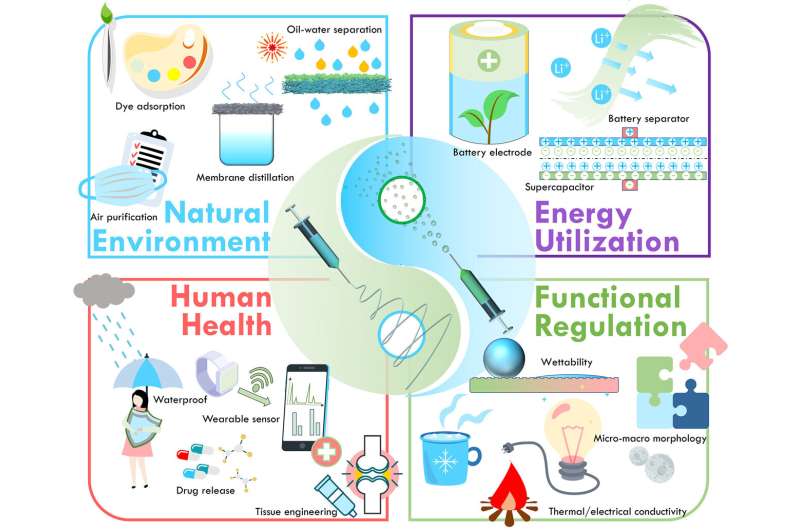This article has been reviewed according to Science X's editorial process and policies. Editors have highlighted the following attributes while ensuring the content's credibility:
fact-checked
peer-reviewed publication
trusted source
proofread
A positive spin: Electrospinning and electrospraying synergism for the nanomaterials industry

Combining two twins-tech—electrospinning and electrospraying—to fabricate novel nanomaterials is an urgent area of research for materials scientists and biomedical engineers, according to a new paper by Professor Hu Jinlian of City University of Hong Kong (CityUHK) published in Matter.
Electrospinning and electrospraying synergism (ESS) can positively impact diverse sectors, from bioengineering and textile technology to medical treatment, defense technology, intelligent manufacturing to energy conversion, argues Professor Hu, who researches electrospinning, electrospraying, nanofibers, nanomaterials, human health and functional membranes.
"This highly integrated ESS technology has received great attention from scientists in the last decade, but we are now facing a critical bottleneck period and seeing hidden problems because of rapid development over the past decade," explains Professor Hu, who is the Director of the Laboratory of Wearable Materials for Healthcare and holds a joint appointment in CityUHK's Department of Materials Science and Engineering and Department of Biomedical Engineering.
EES technology has incomparable advantages over other micro-nano material preparation technologies. It offers to reduce the steps needed in micro-nano material preparation technologies, such as 3D printing, lithography, or other chemical methods; it provides outstanding controllability of diameter, orientation, morphology, density, pore size, and chemical properties of nanofibers; and realizes the perfect combination of 1D fiber and 0D/3D micro-nano particles.
However, the challenges are many. They include a need for more systematic generalization, summary and classification, and the disconnection between the research community and the industry.
Hu argues that the focus of ongoing research into combining electrospinning and electrospraying mechanisms tends to avoid the issue of the synergy of the two processes and instead highlights the two separate technologies, glossing over the advantages that can be captured by the possible coordination and cooperation between the two.
"If the concept of EES technology can be generalized, it will undoubtedly give scientists new ideas and inspire many studies. In turn, it can also vigorously promote the iteration and upgrade of EES technology," Professor Hu argues.
The Matter paper "Electrospinning and electrospraying synergism: Twins-tech collaboration across dimensions" explains that electrospraying and electrospinning are fundamentally similar processes. However, there are differences.
"E-spinning technology is often used as the construction method of the main structure. It should be noted that e-spinning technology can sometimes be used for surface modification or regulation purposes. E-spraying technology is generally used as the control or modification means of material properties," Professor Hu says.
So, what will EES create in the future?
First, EES technology will significantly enrich the preparation of micro-nano composite materials. It will be possible to prepare complex structures that are difficult to obtain by traditional chemical methods, which is essential in catalysis, drug loading and biological detection.
Second, the EES technology will revolutionize the field of functional apparel. Giving apparel special functions, such as waterproofing, cooling/warming, anti-ultraviolet, health detection, etc., will become a trend of commodity development.
Additionally, industrial assembly lines of EES equipment will enter the factory and complete supply chains, while sales channels will gradually appear.
Using the two processes together rather than separately, researchers can contribute to several fields, for example, in the natural environment field, through purification, recovery, and reuse of water resources using porous membrane materials.
In addition to purifying polluted water, nanofiber membranes based on the EES strategy can be used for water harvesting, directly converting water vapor from the environment into clean water. Applications of EES in energy utilization, human health, and functional membranes are also possible.
"EES technology has become an important means of preparing micro-nanoscale composite functional materials over the past 20 years. This is a critical period for its ability to overcome major challenges and move toward future success. We should have an open, enterprising, and innovative mentality to promote the next round of the EES technological revolution," Professor Hu concludes.
More information: Matter (2024). DOI: 10.1016/j.matt.2024.01.009
Journal information: Matter
Provided by City University of Hong Kong



















